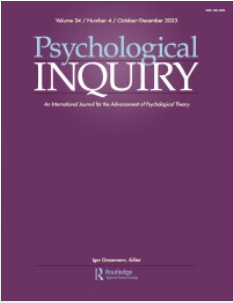Economic Values, Social Values and Cultural Animal Theory
IF 4.1
2区 心理学
Q1 PSYCHOLOGY, MULTIDISCIPLINARY
引用次数: 0
Abstract
Baumeister and Bushman (this issue) offer a cultural animal theory of partisan hostility (hereafter CAT) with the specific aim of explaining the root drivers of political conflict. CAT posits that competition for power revolves around oppositional worldviews reflecting preferences attached to the two primary objectives of all successful societies: amassing and distributing resources. Based on this premise CAT seeks not only to help explain the persistence of the themes motivating political conflict, but also to shed light on the underlying causes of growing levels affective polarization widely documented in the United States and other liberal democracies. CAT takes on a large and complicated slice of the social world; its stated scope is to cover nothing less than the majority of political conflict. That is an ambitious goal for any theoretical project, and the sheer variety and complexity of the analytical target means explanatory gaps and exceptions are inevitable. To their credit, Baumeister and Bushman recognize this, and explicitly acknowledge that CAT makes no claims to be a universal explanatory framework, but is a formulation aimed at being, “correct far more often than not.” Within the limits hinted at, CAT is, in my judgment, quite successful. It is certainly a framework that can be readily employed to generate testable hypotheses, and may point to de-escalation opportunities. While I find much to praise in this framework, in what follows I focus on what I see as two key, and not fully acknowledged, limitations of CAT. I argue that CAT is essentially an economic theory of political conflict which, if correct, has two important implications: (1) A broad swath of the explanatory horsepower CAT is designed to provide is readily available from existing frameworks, and, (2) like other economic theories CAT’s explanatory power decreases considerably when the focus shifts from self-interested resource distribution to the conflicts anchored in social values, and it is the latter that is core to understanding hostile partisan disagreements.经济价值观、社会价值观与文化动物理论
鲍迈斯特和布什曼(本期)提出了一种关于党派敌对(以下简称CAT)的文化动物理论,其具体目的是解释政治冲突的根源。CAT认为,权力竞争围绕着对立的世界观展开,反映了所有成功社会的两个主要目标:积累和分配资源。基于这一前提,CAT不仅试图帮助解释引发政治冲突的主题的持续性,而且还揭示了在美国和其他自由民主国家广泛记录的日益严重的情感两极分化的根本原因。CAT承担了社会世界中一个庞大而复杂的部分;其规定的范围是涵盖大多数政治冲突。对于任何理论项目来说,这都是一个雄心勃勃的目标,而分析目标的多样性和复杂性意味着解释上的差距和例外是不可避免的。值得赞扬的是,Baumeister和Bushman认识到了这一点,并明确承认CAT并没有声称自己是一个通用的解释框架,而是一个旨在“在大多数情况下是正确的”的表述。根据我的判断,在暗示的范围内,CAT相当成功。这当然是一个框架,可以很容易地用来产生可测试的假设,并可能指向降级的机会。虽然我在这个框架中发现了很多值得赞扬的地方,但在接下来的内容中,我将重点放在我认为CAT的两个关键而未被充分承认的局限性上。我认为CAT本质上是一种政治冲突的经济理论,如果正确的话,它有两个重要的含义:(1) CAT旨在提供的大量解释力可以从现有框架中轻易获得;(2)与其他经济理论一样,当焦点从自利资源分配转移到锚定在社会价值中的冲突时,CAT的解释力会大幅下降,而后者是理解敌对党派分歧的核心。
本文章由计算机程序翻译,如有差异,请以英文原文为准。
求助全文
约1分钟内获得全文
求助全文
来源期刊

Psychological Inquiry
PSYCHOLOGY, MULTIDISCIPLINARY-
CiteScore
10.30
自引率
1.10%
发文量
31
期刊介绍:
Psychological Inquiry serves as an international journal dedicated to the advancement of psychological theory. Each edition features an extensive target article exploring a controversial or provocative topic, accompanied by peer commentaries and a response from the target author(s). Proposals for target articles must be submitted using the Target Article Proposal Form, and only approved proposals undergo peer review by at least three reviewers. Authors are invited to submit their full articles after the proposal has received approval from the Editor.
 求助内容:
求助内容: 应助结果提醒方式:
应助结果提醒方式:


